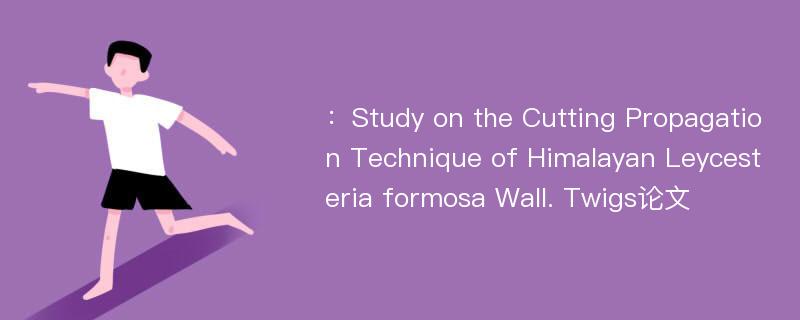
本文主要研究内容
作者(2019)在《Study on the Cutting Propagation Technique of Himalayan Leycesteria formosa Wall. Twigs》一文中研究指出:[Objectives] The study aimed to protect the good germplasm resources of Himalayan Leycesteria formosa Wall. and produce a large number of L. formosa plants used in Tibetan garden landscape. [Methods] In the intelligent solar greenhouse, the effects of different concentrations of ABT2 rooting powder on the cutting propagation of L. formosa twigs were studied, and the effects of different matrices on the growth of the cutting seedlings were analyzed. [Results] The effect of different concentrations of ABT2 rooting powder on the rooting rate of L. formosa is as follows: 200 mg/L>300 mg/L>100 mg/L, and the rooting rate is as follows: 61%>59%>57%. The rooting rate of L. formosa in the control group(CK) was 54%. The average number of roots and the average length of main root of L. formosa in the three treatments with ABT2 rooting powder were significantly different, while the average number of primary roots, average number of new branches, and average number of new leaves of L. formosa treated with 100 mg/L ABT2 rooting powder had no significant difference. There were significant differences between 200 and 300 mg/L ABT2 root powder treatments in the three growth indicators of L. formosa, and the promotion effects of 200 mg/L ABT2 rooting powder on the five indicators of L. formosa cuttings were better. The effects of different transplanting matrices on the indoor survival rate of L. formosa cutting seedlings were very obvious, and the survival rate of L. formosa cutting seedlings in matrix C was the highest, up to 96%. Different substrates had different effects on the growth of ground diameter of L. formosa cutting seedlings, and the promotion effect of matrix C was better. [Conclusions] In the rapid cutting propagation of good L. formosa, 200 mg/L ABT2 rooting powder can be selected. For indoor transplanting, matrix C(sandy soil+perlite+humus soil) should be used.
Abstract
[Objectives] The study aimed to protect the good germplasm resources of Himalayan Leycesteria formosa Wall. and produce a large number of L. formosa plants used in Tibetan garden landscape. [Methods] In the intelligent solar greenhouse, the effects of different concentrations of ABT2 rooting powder on the cutting propagation of L. formosa twigs were studied, and the effects of different matrices on the growth of the cutting seedlings were analyzed. [Results] The effect of different concentrations of ABT2 rooting powder on the rooting rate of L. formosa is as follows: 200 mg/L>300 mg/L>100 mg/L, and the rooting rate is as follows: 61%>59%>57%. The rooting rate of L. formosa in the control group(CK) was 54%. The average number of roots and the average length of main root of L. formosa in the three treatments with ABT2 rooting powder were significantly different, while the average number of primary roots, average number of new branches, and average number of new leaves of L. formosa treated with 100 mg/L ABT2 rooting powder had no significant difference. There were significant differences between 200 and 300 mg/L ABT2 root powder treatments in the three growth indicators of L. formosa, and the promotion effects of 200 mg/L ABT2 rooting powder on the five indicators of L. formosa cuttings were better. The effects of different transplanting matrices on the indoor survival rate of L. formosa cutting seedlings were very obvious, and the survival rate of L. formosa cutting seedlings in matrix C was the highest, up to 96%. Different substrates had different effects on the growth of ground diameter of L. formosa cutting seedlings, and the promotion effect of matrix C was better. [Conclusions] In the rapid cutting propagation of good L. formosa, 200 mg/L ABT2 rooting powder can be selected. For indoor transplanting, matrix C(sandy soil+perlite+humus soil) should be used.
论文参考文献
论文详细介绍
论文作者分别是来自Medicinal Plant的,发表于刊物Medicinal Plant2019年04期论文,是一篇关于,Medicinal Plant2019年04期论文的文章。本文可供学术参考使用,各位学者可以免费参考阅读下载,文章观点不代表本站观点,资料来自Medicinal Plant2019年04期论文网站,若本站收录的文献无意侵犯了您的著作版权,请联系我们删除。
